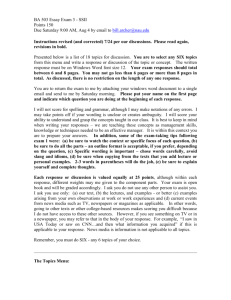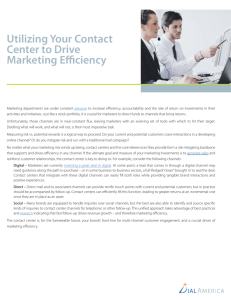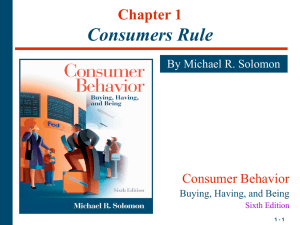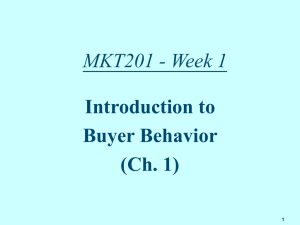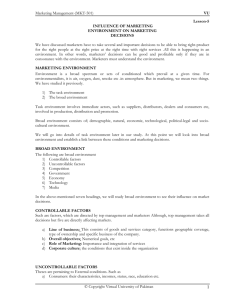作业1
advertisement
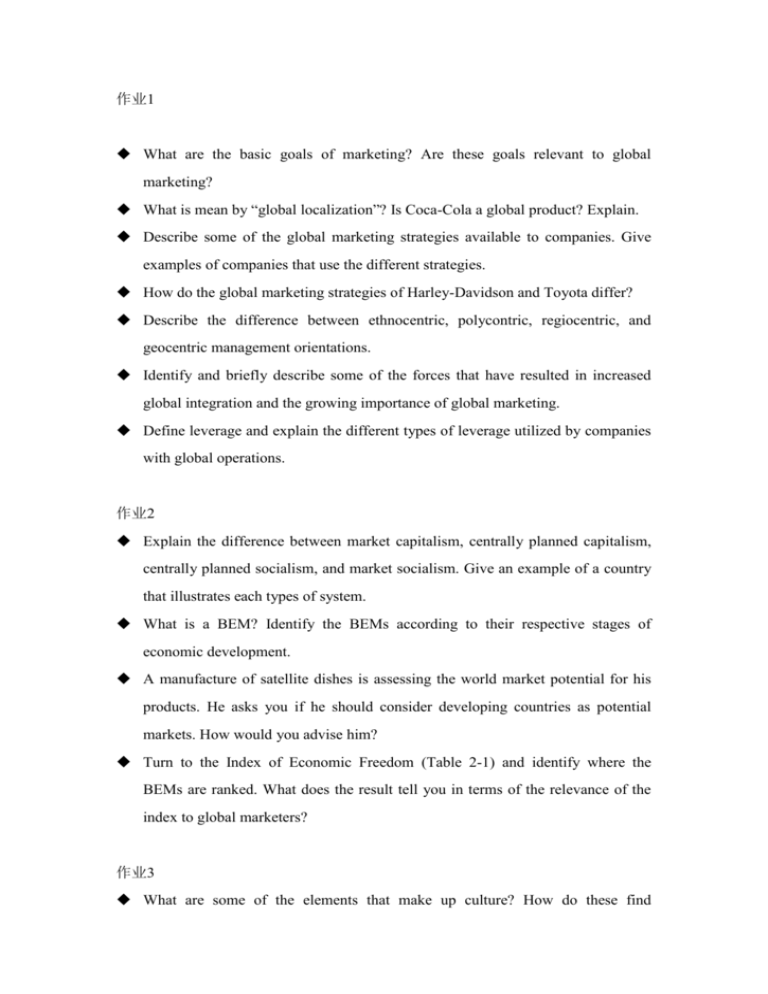
作业1 What are the basic goals of marketing? Are these goals relevant to global marketing? What is mean by “global localization”? Is Coca-Cola a global product? Explain. Describe some of the global marketing strategies available to companies. Give examples of companies that use the different strategies. How do the global marketing strategies of Harley-Davidson and Toyota differ? Describe the difference between ethnocentric, polycontric, regiocentric, and geocentric management orientations. Identify and briefly describe some of the forces that have resulted in increased global integration and the growing importance of global marketing. Define leverage and explain the different types of leverage utilized by companies with global operations. 作业2 Explain the difference between market capitalism, centrally planned capitalism, centrally planned socialism, and market socialism. Give an example of a country that illustrates each types of system. What is a BEM? Identify the BEMs according to their respective stages of economic development. A manufacture of satellite dishes is assessing the world market potential for his products. He asks you if he should consider developing countries as potential markets. How would you advise him? Turn to the Index of Economic Freedom (Table 2-1) and identify where the BEMs are ranked. What does the result tell you in terms of the relevance of the index to global marketers? 作业3 What are some of the elements that make up culture? How do these find expression in your native culture? What is the difference between a low-context culture and a high-context culture? Give an example of a country that is an example of each type and provide evidence for your answer. How can Hofstede’s cultural typologies help Western marketers better understand Asian culture? Explain the self-reference criterion. Go to the library and find examples of product failures that might have been avoided through the application of the SRC. Compare and contrast USA and Japan in terms of traditions and organizational behavior and norms. 作业4 What is sovereignty? What is it an important consideration in the political environment of global marketing? Describe some of the sources of political risk. Specially, what forms can political risk take? Briefly describe some of the differences between the legal environment of a country that embraces common law and one that observes civil law. Global marketers can avoid legal conflicts by understanding the reasons conflicts arise in the first place. Identify and describe several legal issues that relate to global commerce. “See you in court” is one way to respond when legal issues arise. What other approaches are possible? 作业5 Explain two information technology puts powerful tools in the hands of global marketers. What are the different modes of information acquisition? Which is the most important for gathering strategic information? Outline the basic steps of the market research process. What is the difference between existing, latent, and incipient demand? How might these differences affect the design of a marketing research project? Describe some of the analytical techniques used by global marketers. When is it appropriate to use each technique? 作业6 differentiate the five basic segmentation strategies. Give an example of a company that has used each one. Explain the difference between segmenting and targeting. Compare and contrast standardized, concentrated, and differentiated global marketing. Illustrate each strategy with an example from a global company. What is positioning? Identify the different positioning strategies presented in the chapter and give examples of companies or products that illustrate each. What is global consumer culture positioning? What other strategic positioning choices do global marketers have? What is high-touch product? Explain the difference between high-tech product positioning and high-touch product positioning. Can some products be positioned using both strategies? Explain. 作业7 What are the advantages and disadvantages of using licensing as a market entry tool? Give examples of companies from different countries that use licensing as a global marketing strategy. What is foreign direct investment? What forms can FDI take? Do you agree with Ford’s decision to acquire Jaguar? What was more valuable to Ford---the physical assets or the name? What is meant by the phrase global strategic partnership? In what ways does this form of market entry strategy differ from more traditional forms such as joint ventures? What are Keiretsu? How does this form of industrial structure affect companies that compete with Japan or that are trying to enter the Japanese market? Which Strategic options for market entry or expansion would a small company be likely to pursue? A large company? 作业8 What is the difference between a product and a brand? How do local, international, and global products differ? Cite examples What are some of the elements that make up a brand? Are these elements tangible or intangible? What criteria should global marketers consider when making product design decisions? How can buyer attitudes about a product’s country of origin affect marketing strategy? Identify several global brands. What are some of the reasons for the global success of the brands you chose? Briefly describe various combinations of product-communication strategies available to global marketers. When is it appropriate to use each? 作业9 What are the basic factors that affect price in any market? What considerations enter into the pricing decision? Define the various types of pricing strategies and objectives available to global marketers. Identify some of the environmental constraints on global pricing decisions. Why do price differences in world markets often lead to gray marketing? What is dumping? Why was dumping such an important issue during the Uruguay Round of GATT negotiations? What is transfer price? Why is it an important issue for companies with foreign affiliates? Why did transfer pricing in Europe take on increased importance in 1999? What is the difference between ethnocentric, polycontric, and geocentric pricing strategies? Which one would you recommend to a company that has global market aspirations? Compare and contrast the different forms of countertrade. 作业10 In what ways can channel intermediaries create utility for buyers? What factors influence the channel structures and strategies available to global marketers? What is cherry picking? What approaches can be used to deal with this problem? Compare and contrast the typical channel structures for consumer products and industrial products. Identify the different forms of retailing and cite an example of each form. Identify retailers from as many different countries as you can. Identify the four retail market expansion strategies discussed in the text. What factors determine the appropriable mode? What special distribution challenges exist in Japan? What is the best way for a non-Japanese company to deal with these challenges? 作业11 In what ways can global brands and global advertising campaigns benefit a company? How does the “standardized versus localized” debate apply to advertising? What is the difference between an advertising appeal and creative execution? When creating advertising for world markets, what are some of the issues that art directorsand copywriters should take into account? How do the media options available to advertisers vary in different parts of the world? What can advertiser do to cope with media limitations in certain countries? How does public relations differ from advertising? Why is PR especially important for global companies? What are some of the ways public relations practices vary in different parts of the world? 作业12 How can a company measure its competitive advantage? How does a firm know if it is gaining or losing competitive advantage? Cite a global company and its source of competitive advantage. Outline Porter`s five forces model of industry competition. How are the various barriers to entry relevant to global marketing? How does the five partners, or flagship model, developed by Rugman and D`Aveni differ from Porter`s five forces model? Give an example of company that illustrates each of the four generic strategies that can lead to competitive advantage: overall cost leadership, cost focus, differentiation, and differentiation focus. Briefly describe Hamel and Prahalad`s framework for competitive advantage. How can a nation achieve competitive advantage? According to current research on competitive advantage, what are some of the shortcomings of Porter`s models? What is the connection, if any, between national competitive advantage and company competitive advantage? Explain and discuss. 作业13 Briefly review the key innovations that culminated in the digital revolution. What is the basic technological process that made the revolution possible? What is convergence? How is convergence affecting Sony? Kodak? Nokia? What is the innovator’s dilemma? What is the difference between sustaining technology and disruptive technology? Briefly review Christensen’s five principles of disruptive innovation. What key issues must be addressed by global companies that engage in e-commerce? Briefly outline Web design issues as they pertain to global marketing. Review the key products and services that have emerged during the digital revolution. What are some products and services that are not mentioned in the chapter?



